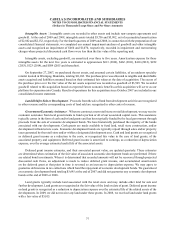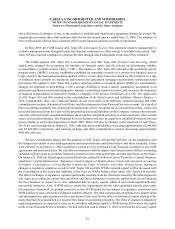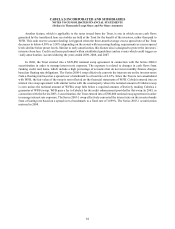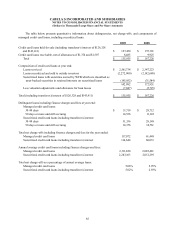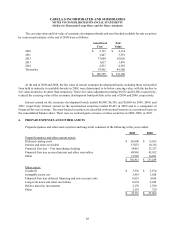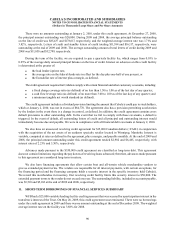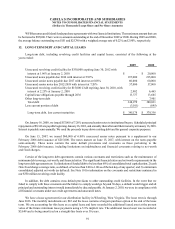Cabela's 2009 Annual Report Download - page 90
Download and view the complete annual report
Please find page 90 of the 2009 Cabela's annual report below. You can navigate through the pages in the report by either clicking on the pages listed below, or by using the keyword search tool below to find specific information within the annual report.81
CABELA’S INCORPORATED AND SUBSIDIARIES
NOTES TO CONSOLIDATED FINANCIAL STATEMENTS
(Dollars in Thousands Except Share and Per Share Amounts)
and a discussion of changes, if any, in the method or methods and significant assumptions during the period. We
adopted the provisions these staff positions effective for the second quarter ended June 27, 2009. The adoption of
these staff positions did not have a material effect on our financial position or results of operations.
In May 2009, the FASB issued ASC Topic 855, Subsequent Events. This statement requires management to
evaluate subsequent events through the date the financial statements are either issued, or available to be issued. ASC
Topic 855 also requires companies to disclose the date through which subsequent events have been evaluated.
The FASB updated ASC Topic 810, Consolidations, and ASC Topic 860, Transfers and Servicing, which
significantly changed the accounting for transfers of financial assets and the criteria for determining whether
to consolidate a variable interest entity (“VIE”). The update to ASC Topic 860 eliminates the qualifying special
purpose entity (“QSPE”) concept, establishes conditions for reporting a transfer of a portion of a financial asset as
a sale, clarifies the financial-asset derecognition criteria, revises how interests retained by the transferor in a sale
of financial assets initially are measured, and removes the guaranteed mortgage securitization recharacterization
provisions. The update to ASC Topic 810 requires reporting entities to evaluate former QSPEs for consolidation,
changes the approach to determining a VIE’s primary beneficiary from a mainly quantitative assessment to an
exclusively qualitative assessment designed to identify a controlling financial interest, and increases the frequency
of required reassessments to determine whether a company is the primary beneficiary of a VIE. The application
of ASC Topics 810 and 860 resulted in the consolidation of the Trust’s assets and liabilities effective January 3,
2010. Consequently, there was a material impact on our total assets, total liabilities, retained earnings and other
comprehensive income, statement of cash flows, and the components of our Financial Services revenue. As a result of
these accounting standards, the securitization transactions will be accounted for as secured borrowings, credit card
loans and debt issued from the Trust will be presented as assets and liabilities of the Company, various other interests
currently reflected on the consolidated balance sheet will be reclassified primarily to credit card loans, other current
assets, and accrued expenses. The Financial Services business will also be required to establish allowances for loan
losses relating to such assets beginning in fiscal 2010. There will also be changes in the statement of cash flows.
The Trust was consolidated on January 3, 2010, with total assets and liabilities increasing approximately $2,100,000
and $2,200,000, respectively, and retained earnings and other comprehensive income decreasing approximately
$100,000, after tax.
We have evaluated the impact that the guidance of ASC Topics 810 and 860 will have on our compliance with
the financial covenants in our credit agreements and unsecured notes and do not believe that these standards, if they
were effective as of January 2, 2010, would have caused us to be in breach of any financial covenants in our credit
agreements and unsecured notes. We can offer no assurances that the impact from the provisions of these accounting
standards will not cause us to breach financial covenants in our credit agreements and unsecured notes in the future.
On January 21, 2010, the federal agencies issued final rules entitled Risk-Based Capital Guidelines; Capital Adequacy
Guidelines; Capital Maintenance; Regulatory Capital; Impact of Modifications to Generally Accepted Accounting
Principles; Consolidation of Asset-Backed Commercial Paper Programs; and Other Related Issues relating to
changes to regulatory capital as a result of ASC Topics 810 and 860. WFB’s required capital will be increased with
the consolidation of the assets and liabilities of the Trust on WFB’s balance sheet under ASC Topics 810 and 860.
The effect of changes to regulatory capital requirements resulting from the final rules issued by the federal agencies
will cause us to reallocate capital from our Retail and Direct businesses to meet the capital needs of our Financial
Services business, or require us to raise additional debt or equity capital, which in turn could significantly alter
our growth initiatives. Also, if WFB fails to satisfy the requirements for the well-capitalized classification under
the regulatory framework for prompt corrective action, WFB would become subject to regulatory restrictions and
WFB’s ability to issue certificates of deposit could be affected. The final rule provides an optional two-quarter delay
and subsequent two-quarter phase-in (for a maximum of one year) for the effect on risk-based capital relating to the
assets that must be consolidated as a result of the change in accounting principles. The effect of changes to regulatory
capital requirements is expected to cause us to contribute additional capital to WFB during 2010 to meet the capital
needs of our Financial Services business. We had sufficient cash at January 2, 2010, to provide the necessary capital








